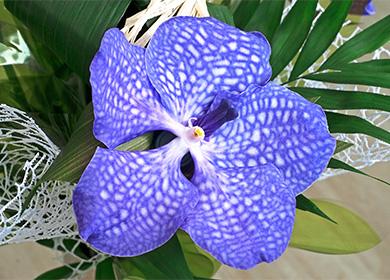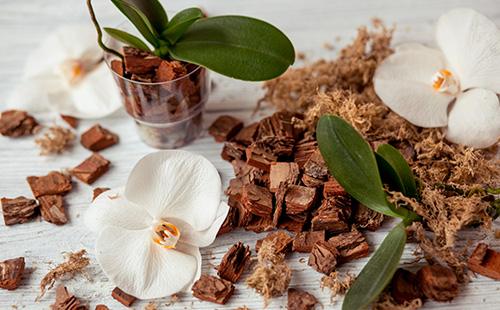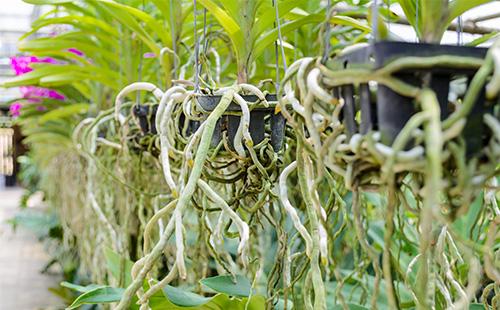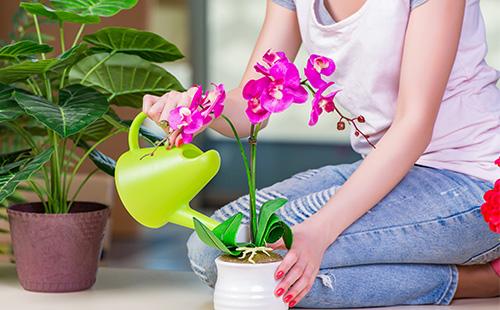The content of the article
Wanda is an epiphytic plant (epiphytes live on trees, but do not parasitize, but use them as a support). Belongs to the orchid family. Grows in a tropical climate. Range - Indonesia, Philippines, North Australia, China.
Botanical Description
An orchid of a monopodial type (there is no pseudobulb, one stem with one growth point is formed). Powerful gray-green roots are covered with porous tissue from dead cells. The fabric easily absorbs moisture from the environment and holds it. Additionally, it performs the function of protecting against aggressive sun exposure.
The stalk is tall, with good care extends up to a meter. The leaves are dense, leathery type, belt-shaped. On the stem are located next, opposite. The color is usually pure green, sometimes with a bluish tint.
During flowering, the vanda releases long peduncles from the leaf sinuses. Each peduncle carries up to 15 buds. Depending on the age and condition of the plant, from one to four peduncles are simultaneously formed. Flowering duration - up to three months. Blooms two to three times a year.
The subtleties of choosing a seedling in the store
When buying a vanda orchid, you need to pay attention to the origin of the plant. It is better to purchase not with hands, but in specialized stores. Examine the tag - it indicates the variety, basic information about the plant.
- Origin and age. It is better not to buy copies imported from other countries. They are very difficult to tolerate acclimatization, often die. Orchids grown in the local climate are preferred. The optimal age of the plant is from two years.
- General state. Carefully inspect the vanda for pests, evaluate its general appearance. The absence of leaves in the lowermost part of the stem is considered normal, exposure to the middle of the height is considered a deviation. The flower is clearly unhealthy or was grown under inappropriate conditions. Because of this, problems with adaptation may occur.
- Root system. The size of the roots does not play a special role. Pay attention to their color. The color of healthy roots is uniform, without spots. The consistency is dense. The presence of soft patches indicates the initial stage of decay.
- Leaves. A healthy leaf is resilient and smooth. Do not buy a vanda with folded in half wrinkled leaves.
Main varieties
The genus includes about 50 species. Wands easily interbreed, which allows breeders to regularly delight florists with new varieties. The most common types of vanda orchid are.
- Wanda is gross. Tall variety with developed root system. In vivo grows up to three meters. In apartments, it does not grow to such sizes. On each peduncle, up to six large flowers are formed. Petals are rounded, the edges are wavy. The lip (fused lower petals) is three-lobed. The middle of the lip is purple, the sides are yellow with small red dots. Color is usually in mid-autumn.
- Wanda is blue. Blue coloring is a rarity among orchids. It looks unusual, interesting, beautiful. The stem is well developed, straight, meter high. Toothed belt-shaped leaves are arranged in two rows. On one peduncle, up to 15 flowers are collected. The color is plain or with a mesh pattern. The lip is small, intensely colored. It blooms in autumn.
- Wanda is three-colored. Height up to one and a half meters. Belt-shaped leaves are arranged in two rows. On each peduncle, up to ten fragrant large flowers are formed. The color is white or cream, often with brownish dots. Petals are egg-shaped, wavy at the edges. The lip is large, guitar-like in the center, painted in bright purple or pink. It blooms repeatedly and continuously - from October to January, from May to June.
Cultivation methods
Due to the aerial roots, the vanda receives moisture and nutrition not only directly from the substrate, but also the environment. Therefore, vanda is grown in classic and non-standard ways.
- In hanging baskets. The roots are bare, the substrate is not used. This is the most common and most successful way of keeping vanda, imitating being in natural conditions. Care for the roots of the vanda orchid in this case comes down to regular spraying. They spray not only the root system, but also the foliage. In summer, sprayed daily, in winter - once every three to four days.
- In a plastic pot. Vanda is planted in a substrate from crushed coniferous bark. Watered less often, only after the substrate is completely dry. Judging by the reviews of experienced gardeners, a pot is not the best solution for a vanda. The risk of rotting the root system increases.
- Growing a vanda orchid in a bulb. A popular, effective, but the most unsuccessful way of growing. Access to narrow glass vases is difficult. The plant does not receive the right amount of oxygen, the root system is not ventilated, it rots. Growing vandas in vases and flasks is not recommended.
Care Basics
Like all orchids, the vanda is demanding on the conditions of detention. Orchid care Wanda at home will organize taking into account its characteristics, the natural environment of growth.
- Lighting. Keep in diffused bright light. Direct sunlight is avoided. Grown on a south or southwest window. In the summer at noon, they shade with tulle. In winter, they fill up with phytolamps.
- Temperature. The permissible temperature range for the spring-summer period is 18–27 ° C. Wanda withstands temperatures up to 35 ° C, subject to shading, regular ventilation and high humidity. By the end of autumn, the temperature is reduced to 15-22 ° C.
- Humidity. A prerequisite is high humidity of at least 60%. The optimal indicator is 80%. They increase humidity in two ways - by systematic spraying, by installing a water tray and decorative pebbles. The use of electronic humidifiers is welcome.
- Top dressing. It is advisable to use special fertilizers for orchids. Universal mineral complexes for flowers make in a reduced dosage. Reduce it by two to three times. Fertilizers in high concentration lead to burns of the root system. The feeding season is in the spring and summer in the phase of active growth.
- The soil. You can use ready-made soil for orchids. But it’s better to cook it yourself.The substrate is composed of pine bark and sphagnum. Additionally add charcoal, polystyrene chips. The largest pieces (bark, polystyrene) are put at the bottom of the pot during planting, the rest of the space is filled with a fine-grained mixture.
- Transfer. Wanda does not like transplants; he is recovering after them for a long time. Transplanted in extreme cases. Indications for transplantation - the transformation of the substrate into dust, its acidification, a small volume of the pot. Transplantation during the flowering period is unacceptable. It is better to do this after flowering or early spring before the start of active growth.
Features of watering and spraying
In the evening, the flower is not watered. Properly water the Wanda orchid in the morning. The roots bathe in warm water for about 15-20 minutes. You can understand that the plant has received enough moisture by changing the color of the roots - they turn green. Daily bathing is recommended only in hot weather. The rest of the time, they take breaks between procedures for two to three days.
To neutralize carbonates, a little citric acid is added to the water for irrigation every three months. You can reduce the frequency of bathing to once a month, the rest of the time is sprayed. It is better to use soft water - spring, rain. For artificial softening of water, you can add special preparations for water in aquariums. They are completely safe for the plant.
If wanda is grown in a glass vase, water is poured directly into them. Changes in the color of the roots, the disappearance of bubbles on the surface and the excess liquid are poured.
Daylight hours
In temperate latitudes, a sufficient amount of light Wanda receives only in the summer. The rest of the time, the lack of light is compensated by the installation of fluorescent lamps. The optimal daylight hours are 12 hours. The table shows data on the duration of daylight hours at different periods of the year and the recommended number of hours of illumination.
Table - How many hours of backlighting do vanda orchids need at different times of the year?
| Month | The average daylight hours in the first half of the month | The average daylight hours in the second half of the month | Backlight clock |
|---|---|---|---|
| January | 7:36 | 8:03 | 4–4,5 |
| February | 8:58 | 9:52 | 2–3 |
| March | 10:50 | 11:49 | 1 |
| April | 13:01 | 14:00 | — |
| May | 15:04 | 15:54 | — |
| June | 16:41 | 17:00 | — |
| July | 16:56 | 16:31 | — |
| August | 15:40 | 14:50 | — |
| September | 13:41 | 12:43 | — |
| October | 11:35 | 10:37 | 1–2 |
| November | 9:29 | 8:37 | 2,5–3,5 |
| December | 7:52 | 7:31 | 4–4,5 |
Care during flowering ...
At the very beginning of flowering, as soon as a peduncle has formed with buds, they put up a support. If you do not do this right away, the peduncle will bend under the weight of the opened flowers. To achieve magnificent flowering and increase its duration, you can create favorable conditions.
- A place. Without unnecessary need, do not rearrange the flower pot. Try not to change the position of the pot at all. Wanda can drop buds.
- Pot. The state of the root system is directly related to the formation of peduncles. If vanda is grown in a pot, it must be transparent so as not to interfere with the processes of photosynthesis.
- Backlight If the vanda bloomed in winter, backlighting is mandatory. First of all, the peduncle itself, its tip should be illuminated.
- Temperature. An important condition for abundant flowering is the daily temperature differences of about 5 ° C. During the flowering period, the vandu is kept in cool no higher than 22 ° C.
- Top dressing. Flowering stimulates the introduction of phosphorus and potassium. Nitrogen stimulates growth, but prevents the formation of buds.
… and after
After flowering with an orchid, a vanda performs a series of procedures. The flower stalk is recommended to be cut only after it has completely dried. Inside it is hollow - if water gets into the hole during watering, rotting of the trunk cannot be avoided. Immediately after trimming it is better to cover it with beeswax.
Peduncle with a green tip do not touch. After a while, buds may form on it again. Try pruning the peduncle over the third knot after falling flowers. There is a possibility of a new peduncle in a couple of months. But repeated flowering will not be so plentiful and long.
Breeding
The main method of propagating Vanda orchids at home is by children. Children are lateral processes. They are formed infrequently and only on adult orchids. At the time of separation, the baby should have its own roots. The child shoots are carefully cut with a sharp blade, the places of the cuts are treated with coal powder.
Planted in a loose substrate, create greenhouse conditions. Imitated home greenhouse - a box covered with polyethylene or glass. Humidity inside the greenhouse should not fall below 85%. The beginning of growth indicates successful rooting. Rooted children are planted in individual pots.
The second method is the rooting of apical cuttings with aerial roots. Cut them from the side shoots. Rooted cuttings in a mixture of sphagnum, pine bark and fern roots. The conditions are identical to the rooting of children.
Growing problems
Wanda is attacked by common pests of houseplants - aphids, spider mites, scale insects, thrips. The main way to combat them is with insecticide treatment. Preparations of universal action - Actellik, Aktara, Inta-vir.
When decaying the roots, Wanda advises fungicides to treat orchid orchids. The optimal remedy for such cases is Fitosporin. All damaged areas are cut out and treated with coal powder. Often there are problems that are not related to diseases and insects. The following table will help determine the cause.
Table - Problems with growing Wanda orchids and what causes them
| Problem | Probable reasons |
|---|---|
| Lack of flowering | - lack of light; - excess nitrogen; - no daily temperature drops |
| Peduncle dies to bloom | - Defeat with a spider mite or thrips; - dry air and soil |
| Falling colors | - Spider mite or thrips: - prolonged lack of watering; - too high temperature; - moving a flower pot; - change in conditions of detention |
| Yellow leaves | - Excess of light; - weak, irregular watering; - lack of trace elements; - high air temperature |
| Root growth stopped | - Lack of light in the winter; - low air temperature; - dry air or soil |
| Rotten roots | - Dense substrate; - stagnation of water; - fungal disease. |
| Wither leaves | - hit by direct rays of the sun; - pests; - dry air; - cold |
Caring for a Wanda orchid is not as difficult as it might seem at first glance. It takes a little patience, time and knowledge. The applied efforts are fully paid off by beautiful, long flowering.




